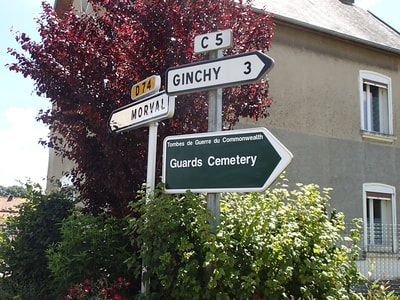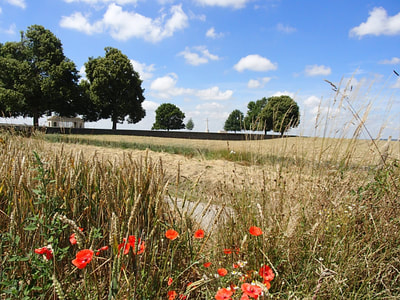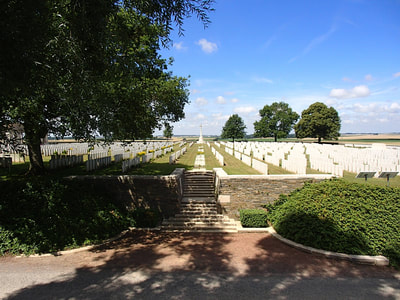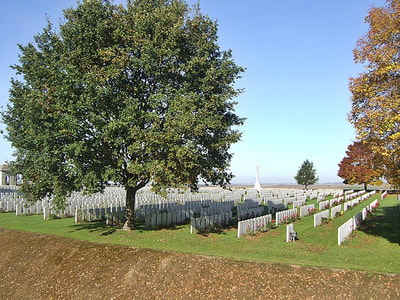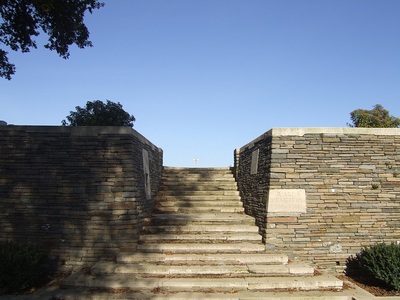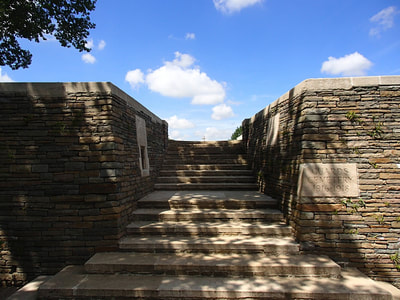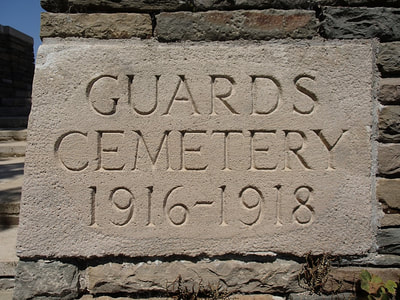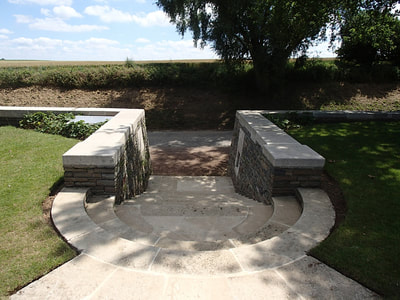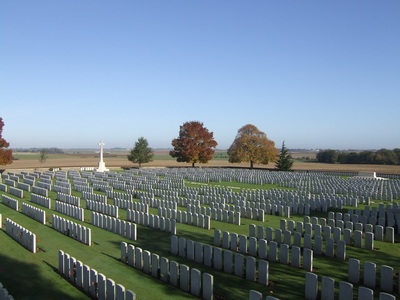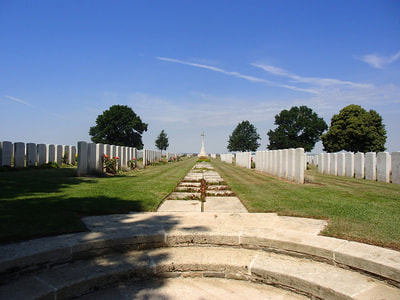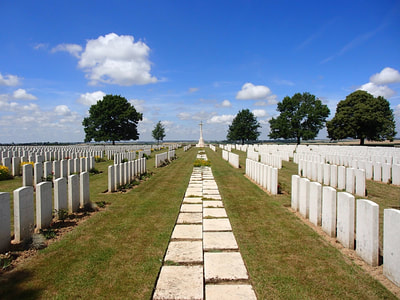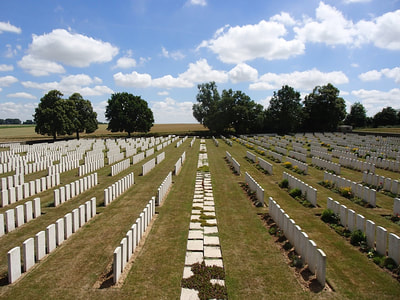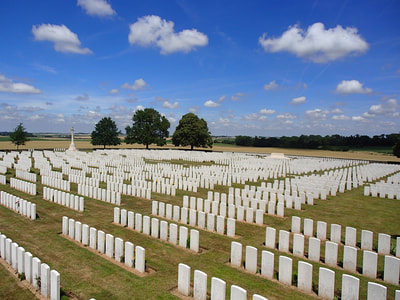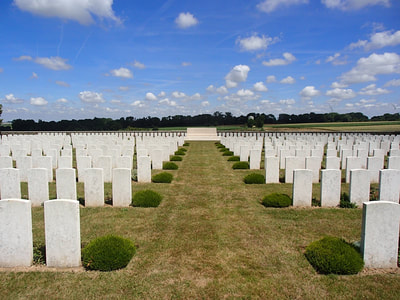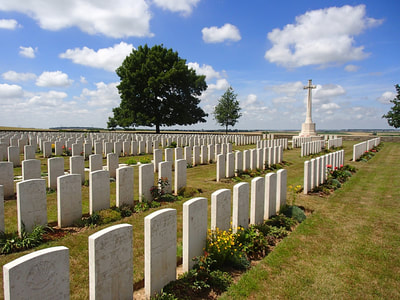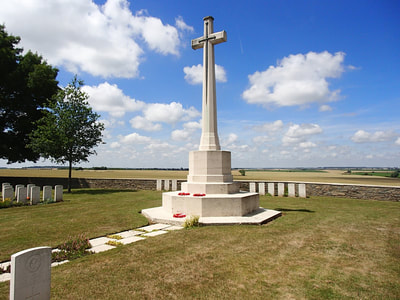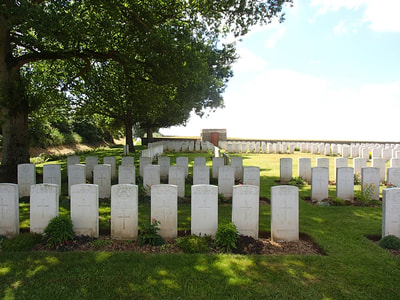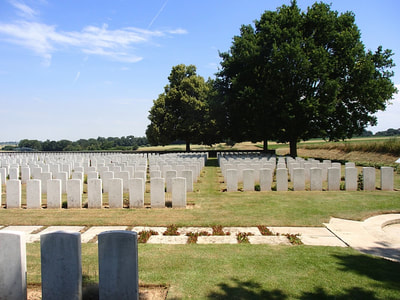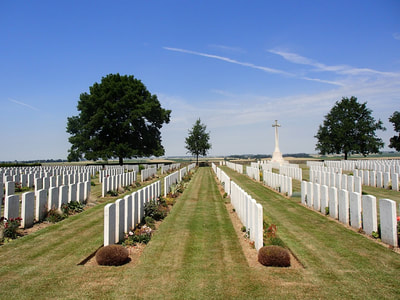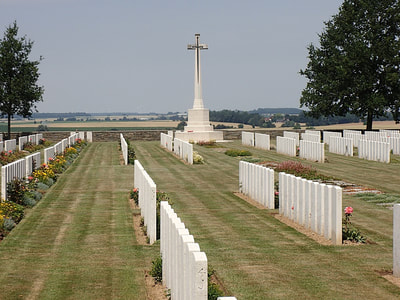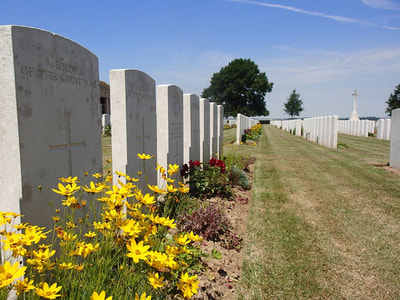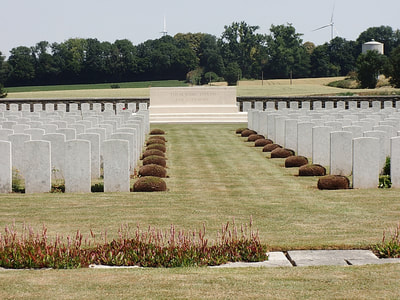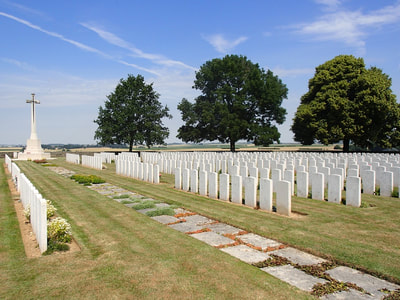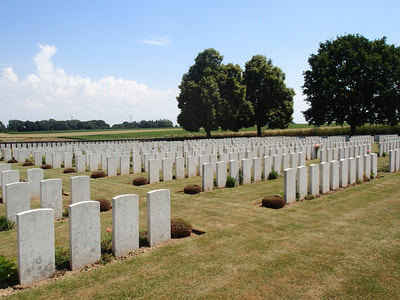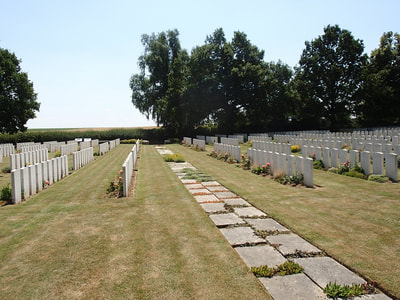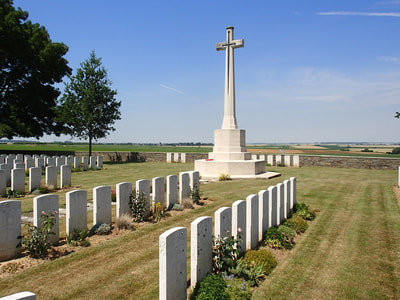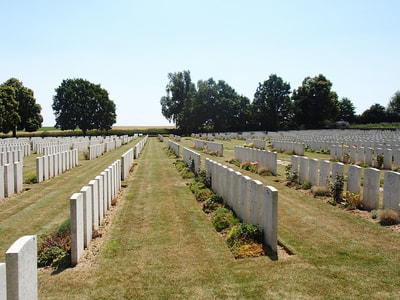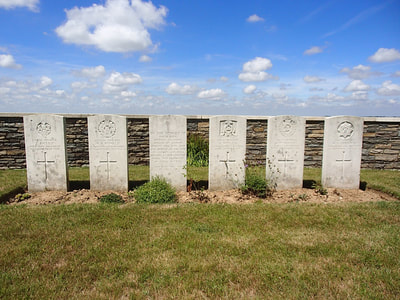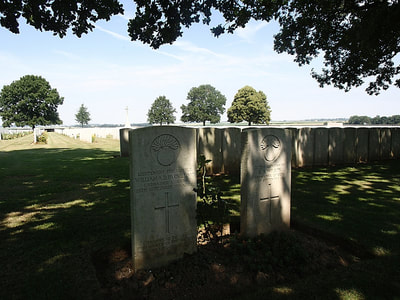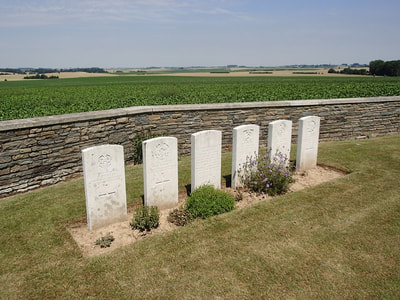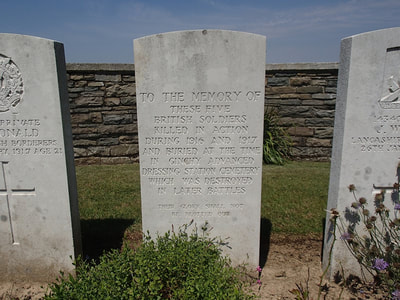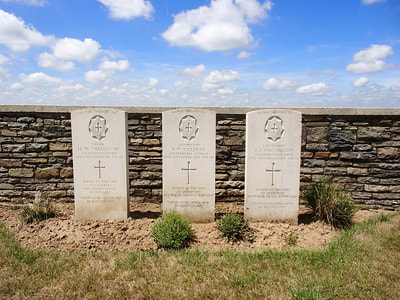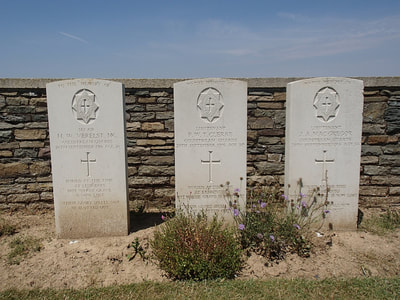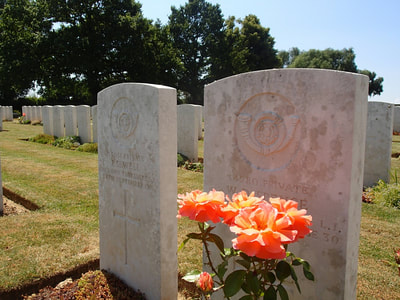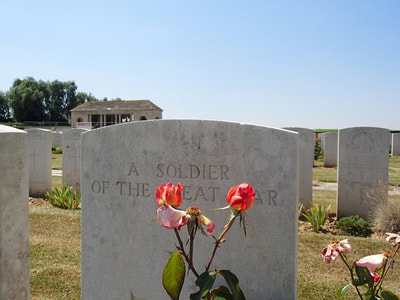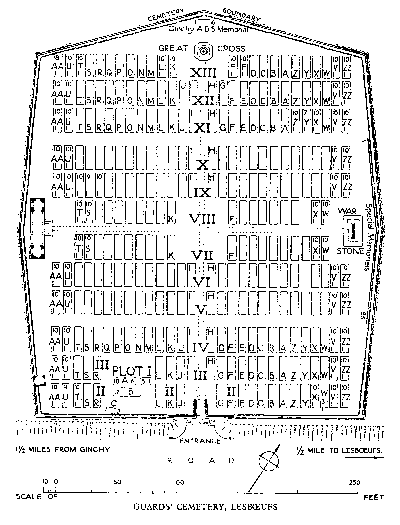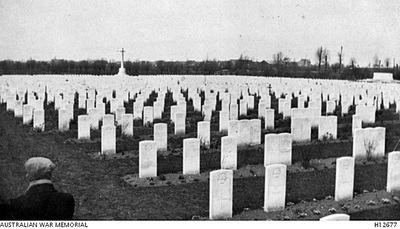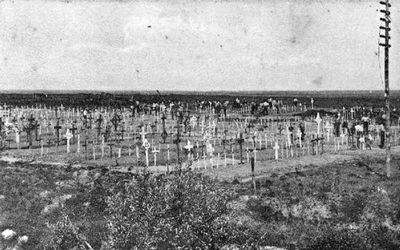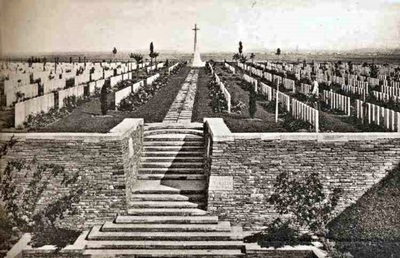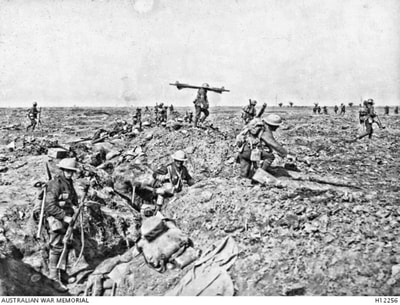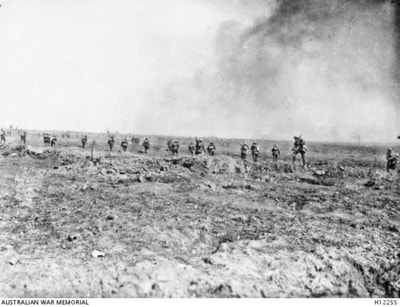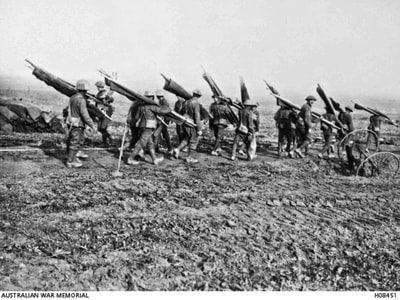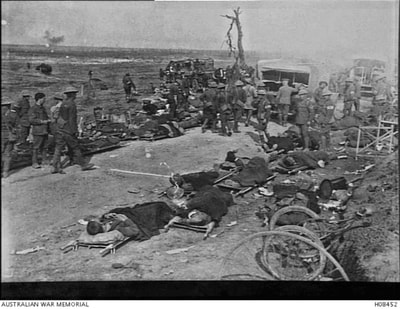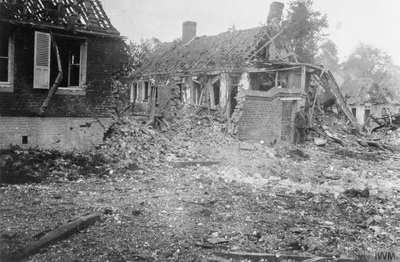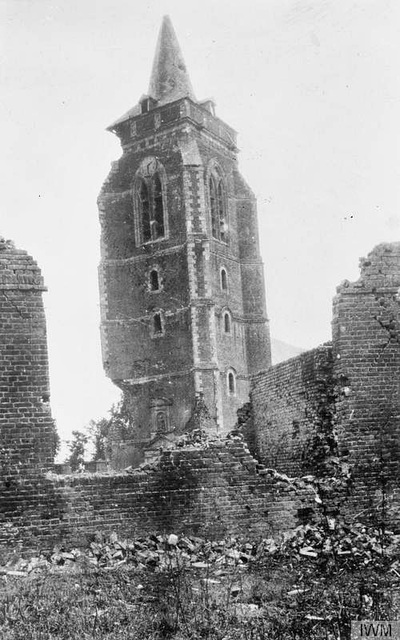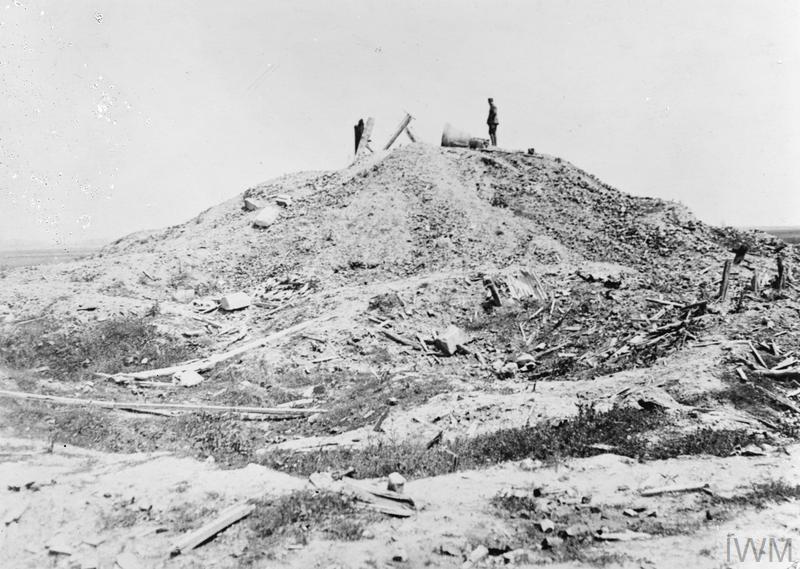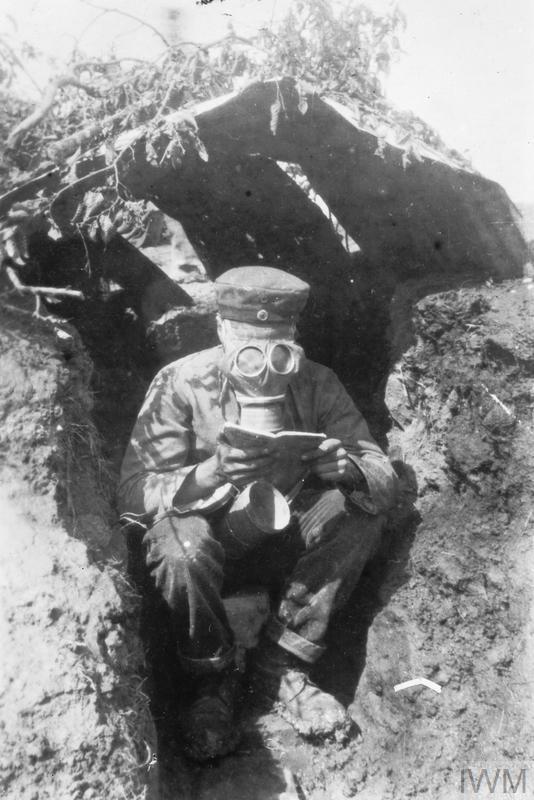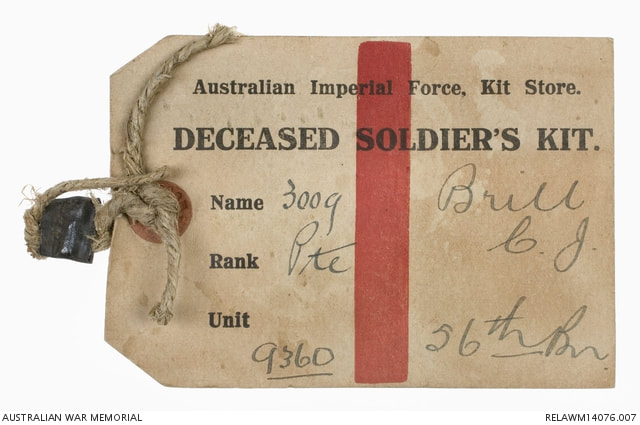GUARDS' CEMETERY
Lesboeufs
Pas De Calais
France
Roll of Honour
Listed by Surname
Location Information
Lesboeufs is a village 16 kilometres north-east of Albert. From Arras take the N17 south. Then after Bapaume, take the D19 to Lesboeufs. Take the right fork by the Church through Le Transloy to Leboeufs village, then take the C5 towards Ginchy. The Cemetery is on the right hand side.
Visiting Information
The location or design of this site make wheelchair access impossible.
Historical Information
Lesboeufs was attacked by the Guards Division on 15 September 1916 and captured by them on the 25th. It was lost on 24 March 1918 during the great German offensive, after a stubborn resistance by part of the 63rd Bn. Machine Gun Corps, and recaptured on 29 August by the 10th Bn. South Wales Borderers.
At the time of the Armistice, the cemetery consisted of only 40 graves (now Plot I), mainly those of officers and men of the 2nd Grenadier Guards who died on 25 September 1916, but it was very greatly increased when graves were brought in from the battlefields and small cemeteries round Lesboeufs.
There are now 3,137 casualties of the First World War buried or commemorated in this cemetery. 1,644 of the burials are unidentified but there are special memorials to 83 soldiers known or believed to be buried among them. Other special memorials record the names of five casualties buried in Ginchy A.D.S. Cemetery, whose graves were destroyed by shell fire, and three officers of the 2nd Bn. Coldstream Guards, killed in action on 26 September 1916 and known to have been buried together by the roadside near Lesboefs, whose grave could not later be located.
The cemetery was designed by Sir Herbert Baker
The more considerable burial grounds concentrated into this cemetery were the following:-
FLERS DRESSING STATION CEMETERY, GINCHY, between Delville Wood and Flers, containing the graves of 33 soldiers from Australia and eight from the United Kingdom who fell in September, 1916-March, 1917.
FLERS ROAD CEMETERY, FLERS, on the Flers-Longueval road, containing the graves of 17 soldiers from the United Kingdom, three from New Zealand and one from Australia, who fell in October, 1916.
GINCHY A.D.S. CEMETERY, on the North side of Ginchy village. This was a Field Ambulance cemetery, used from November, 1916 TO March, 1917, and containing the graves of 77 soldiers from the United Kingdom and one from Australia.
GINCHY R.F.A. CEMETERY, between Ginchy and Flers, containing the graves of 16 Artillerymen from the United Kingdom and five from Australia who fell in October, 1916-February, 1917.
GUARDS' BURIAL GROUND, GINCHY, on the East side of the village, containing the graves of 21 officers and men of the Guards Division who fell on the 15th September, 1916.
NEEDLE DUMP CEMETERY, LESBOEUFS, on the road to Flers, containing the graves of 23 soldiers from Australia and four from the United Kingdom who fell in October, 1916-March, 1917.
NEEDLE DUMP SOUTH CEMETERY, LESBOEUFS, about 50 yards South of Needle Dump Cemetery, containing the graves of 14 soldiers from Australia and nine from the United Kingdom who fell in October, 1916-March, 1917.
SWITCH TRENCH CEMETERY, FLERS, a little East of the Flers-Longueval road, containing 110 (mainly Australian) graves of 1916-17. On the site of another part of Switch Trench, further West, the New Zealand Government have erected one of their two Battlefield Memorials in France.
WINDMILL TRENCH CEMETERY, LESBOEUFS, on the road leading North from Lesboeufs. It was used from September, 1916 to March, 1917, and it contained the graves of 27 soldiers from the United Kingdom and 16 from Australia.
Casualty Details: UK 2911, Canada 5, Australia 209, New Zealand 11, Total Burials: 3136
Lesboeufs is a village 16 kilometres north-east of Albert. From Arras take the N17 south. Then after Bapaume, take the D19 to Lesboeufs. Take the right fork by the Church through Le Transloy to Leboeufs village, then take the C5 towards Ginchy. The Cemetery is on the right hand side.
Visiting Information
The location or design of this site make wheelchair access impossible.
Historical Information
Lesboeufs was attacked by the Guards Division on 15 September 1916 and captured by them on the 25th. It was lost on 24 March 1918 during the great German offensive, after a stubborn resistance by part of the 63rd Bn. Machine Gun Corps, and recaptured on 29 August by the 10th Bn. South Wales Borderers.
At the time of the Armistice, the cemetery consisted of only 40 graves (now Plot I), mainly those of officers and men of the 2nd Grenadier Guards who died on 25 September 1916, but it was very greatly increased when graves were brought in from the battlefields and small cemeteries round Lesboeufs.
There are now 3,137 casualties of the First World War buried or commemorated in this cemetery. 1,644 of the burials are unidentified but there are special memorials to 83 soldiers known or believed to be buried among them. Other special memorials record the names of five casualties buried in Ginchy A.D.S. Cemetery, whose graves were destroyed by shell fire, and three officers of the 2nd Bn. Coldstream Guards, killed in action on 26 September 1916 and known to have been buried together by the roadside near Lesboefs, whose grave could not later be located.
The cemetery was designed by Sir Herbert Baker
The more considerable burial grounds concentrated into this cemetery were the following:-
FLERS DRESSING STATION CEMETERY, GINCHY, between Delville Wood and Flers, containing the graves of 33 soldiers from Australia and eight from the United Kingdom who fell in September, 1916-March, 1917.
FLERS ROAD CEMETERY, FLERS, on the Flers-Longueval road, containing the graves of 17 soldiers from the United Kingdom, three from New Zealand and one from Australia, who fell in October, 1916.
GINCHY A.D.S. CEMETERY, on the North side of Ginchy village. This was a Field Ambulance cemetery, used from November, 1916 TO March, 1917, and containing the graves of 77 soldiers from the United Kingdom and one from Australia.
GINCHY R.F.A. CEMETERY, between Ginchy and Flers, containing the graves of 16 Artillerymen from the United Kingdom and five from Australia who fell in October, 1916-February, 1917.
GUARDS' BURIAL GROUND, GINCHY, on the East side of the village, containing the graves of 21 officers and men of the Guards Division who fell on the 15th September, 1916.
NEEDLE DUMP CEMETERY, LESBOEUFS, on the road to Flers, containing the graves of 23 soldiers from Australia and four from the United Kingdom who fell in October, 1916-March, 1917.
NEEDLE DUMP SOUTH CEMETERY, LESBOEUFS, about 50 yards South of Needle Dump Cemetery, containing the graves of 14 soldiers from Australia and nine from the United Kingdom who fell in October, 1916-March, 1917.
SWITCH TRENCH CEMETERY, FLERS, a little East of the Flers-Longueval road, containing 110 (mainly Australian) graves of 1916-17. On the site of another part of Switch Trench, further West, the New Zealand Government have erected one of their two Battlefield Memorials in France.
WINDMILL TRENCH CEMETERY, LESBOEUFS, on the road leading North from Lesboeufs. It was used from September, 1916 to March, 1917, and it contained the graves of 27 soldiers from the United Kingdom and 16 from Australia.
Casualty Details: UK 2911, Canada 5, Australia 209, New Zealand 11, Total Burials: 3136
This tag was attached to the package of personal effects sent home to the family of 3009 Private Clarence James 'Jim' Brill after he was killed in 1917.
Brill was born at Mooroopna, Victoria, the son of Joseph and Kitty Brill. He was almost 28 years old and living at Craigie, NSW when he enlisted in the AIF on 13 July 1915, and was then working as a sawyer in a local saw mill.
Known as 'Snow' to his mates in the AIF, he embarked at Sydney with the 10th reinforcements to 4 Battalion in HMAT Warilda, on 8 October 1915. He joined his battalion at Tel el Kebir in Egypt in January 1916.
In February Brill was transferred to the newly formed 56th Battalion. On 19 June he embarked for France in HT Huntsend, arriving at Marseilles ten days later. He remained with his battalion on the Western Front and was with the battalion every time it went into the front line.
On 14 March 1917 the unit was in the lines at the Somme. Brill was doing engineers' work just behind the front line with his friend 3114 Private John Richard 'Spinkie' Spinks and another man, when their location was hit by German artillery fire. A shell fell between the three men, killing Brill instantly and wounding Spinks and the other man. Shrapnel hit Spinks around the forehead and eyes, blinding him. He was unable to see what had happened to Brill, but shouted for him and tried to find him. Another soldier found Spinks wandering around in shock and Spinks asked him to look for Brill. Spinks was eventually sent to 3 General Hospital in England. There he received a letter telling him that Brill had been killed by the shell that had blinded him. The only casualties for the battalion that day were due to this shell.
Brill was buried at a small cemetery behind Needle Trench, near Lesboeufs, France. Chaplain Alexander Sydney Greville officiated and his friends from the battalion attended. In the 1920s his body was exhumed and reburied at the Guards Cemetery at Lesbouefs. Brill's brother, Leslie William Brill also served in the AIF and was awarded the Military Medal for his work as a stretcher bearer and in dressing stations at Gallipoli in 1915.

